
|
GREATEST FILM SCENES 1960s |
| Film Title/Year and Film Scene Description | ||||||||||
|
# 74. Psycho (1960) Hitchcock's psychological thriller still shocks - especially the brutal shower-murder montage. A young, in-love, attractive real estate office secretary Marion Crane (Janet Leigh) impulsively steals $40,000, flees from Phoenix, and eventually ends up at the deserted Bates Motel. Following a conversation over dinner with the sympathetic, shy, and nervous motel manager Norman Bates (Anthony Perkins), she vows to return and extricate herself from her predicament involving the larcenous crime. As a cleansing act before retiring for the night, she prepares to take a shower. In the next scene, the vulnerable woman is shockingly stabbed to death - it is the most famous murder scene ever filmed. The infamous scene begins peacefully enough. She closes the antiseptic, white-tiled bathroom's door, removes her robe, steps naked into the bathtub, pulls the curtain across, opens up a bar of soap, and turns on the overhead shower water. There in the privacy of her bathroom, she begins to bathe, visibly enjoying the feel of the cleansing water on her skin, relieved as the water washes away her guilt. Large closeups of the shower head reveal the water pouring down on her. The bathroom door opens and a shadowy, grey figure enters the bathroom - seen through the cloudy shower curtain, whips aside the curtain, wields a knife high in the air and repeatedly slashes and stabs at her, shattering her sense of security and salvation. Split-second images of her flesh, the knife, blood, and the bathroom tile flash on the screen. The piercing, shrieking, and screaming of the violin strings of Bernard Herrmann's shrill music play a large part in creating sheer terror during the horrific scene. Marion resists and screams - the killing is kinetically viewed from many angles and views. She is standing in water mixed with blood. She falls against the bathtub tiles, her hand 'clawing and grasping' the back shower wall after the murderer (resembling a grey-haired woman) quickly turns and leaves. In a closeup, Marion holds her hand out, grabs the shower curtain and pulls it down from its hooks as she collapses over the edge of the bathtub - her face is pressed to the bathroom floor. She lies bleeding on the floor, with the shower nozzle still spraying her body with water. The camera slowly tracks the blood and water which flows and swirls together counter-clockwise down into the deep blackness of the bathtub drain. The drain dissolves into a memorable closeup of Marion's dead-still, open right eye with one tear drop (or drop of water). The camera pulls back up from the lifeless, staring eye, spiraling in an opposite clockwise direction and revealing her face - stiff, lying flat on the bathroom floor. |
 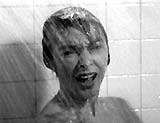 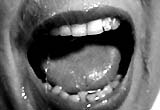 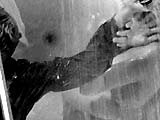    
|
|||||||||
|
# 75a. Lawrence of Arabia (1962) The story of the eccentric British officer T.E. Lawrence (Peter O'Toole) is pervaded with a romantic, golden-hued glow in David Lean's sweeping epic . At age 29, young Lawrence began his career in the British headquarters in Cairo in 1917, working at a desk job, but disgruntled and uninterested in his work as a cartographer coloring maps, he wants to get involved in adventures out in the desert. The dedicated, knowledgeable, but undisciplined Lawrence is assigned to special duty with a transfer to Arabia ("For ordinary men, it's a burning, fiery furnace"). Thinking "it's going to be fun," he contemplates his future while gazing into a lit match as it burns down - it is an exultant image. As he blows the burning hot match out, rather than snuffing it out with his fingers ("The trick...is not minding that it hurts"), the screen becomes overwhelmed by the magnificent glow of the blazing, reddish-orange Arabian sun, first seen as a growing sliver of bright light, then slowly rising over the endless horizon of the golden sand-duned desert - the site of his new mission. |
  
|
|||||||||
|
# 75b. Lawrence of Arabia (1962) [Two other resonant images in the film]: (1) The suspenseful scene of the appearance of Sheik Sherif Ali Ibn el Kharish (Omar Sharif) with the effective use of a long lens - at a Harith watering well at Masruh (belonging to a rival Bedouin tribe), Lawrence's (Peter O'Toole) assistant Tafas draws up water at the start of one of the longest, most memorable entrances in film history. A dust cloud and then a tiny speck appear through shimmering, mirage-like heat waves on the desert horizon - Lawrence fears it is "Turks." In the haze, the ominous image steadily enlarges and grows into a human being as it comes closer and closer. Dramatically, the black-robed Bedouin Sherif Ali shoots down Lawrence's escort in cold-blood, illustrating through this ugly, ferocious act the fact of ancient Bedouin tribal warfare. (2) Lawrence is positioned on a sand dune ridge in one of the film's most memorable sequences - he pushes a plunger to detonate dynamite laid on the tracks of a Turkish train. The Arabs open fire with British machine guns on the derailed train. Lawrence calls for his men to stop, then rises in his flowing white robes and runs in front of the line of fire, shooting flares to get his men's attention and crying "Stop it!" Then, with one sweeping hand, he leads the bloody desert assault down the sand dune hillside: "Come on, men!" The men loot the train for treasures. Lawrence strides atop the wrecked train, where he is shot in the right upper arm by a wounded Turkish officer and falls to the ground. He faces and watches as the Turkish man unsteadily empties his revolver directly at him. After the man is swiftly dispatched by the swipe of a sword, Lawrence is photographed in front of his hero-worshipping followers. His arm bloodied, he climbs back aboard the roof of the train in his sandals and long-flowing robe, parading triumphantly like a god before rows of cheering Arabs enthusiastically chanting: "Aurens, Aurens." In a long tracking shot, the charismatic, egotistical figure casts a giant shadow on the ground that his men follow. He is framed against the bright sun - his arms outstretched.
|
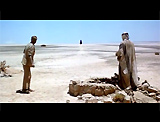  
|
|||||||||
|
# 76. Lolita (1962) Stanley Kubrick's brilliant adaptation of Vladimir Nabokov's celebrated yet controversial novel was a satire on American sexual attitudes evidenced in a middle-aged man's unusual sexual passion/obsession for a very young girl. The film's publicity posters asked the audacious tagline: "How did they ever make a film of Lolita?" with a picture of Lolita wearing heart-shaped sunglasses and licking a red lollipop. Toward the beginning of the film, Humbert Humbert (James Mason), an impeccable, European intellectual examines summer lodgings in New Hampshire in the home of a matronly-looking, boorish, wealthy Charlotte Haze (Shelley Winters). He is convinced to board there after being shown the garden in the backyard: "My flowers win prizes around here! They're the talk of the neighborhood. Voila!" Juxtaposed with these lines from Charlotte is the first view of her nubile, young, sultry twelve-year-old daughter, Dolores 'Lolita' Haze (Sue Lyon) languidly sunbathing on a blanket on the lawn. She looks up and stares cooly at the new prospective boarder with a blank expression - the soundtrack plays a nymphet tune. The first image of her youthful figure is impossible to forget - Lolita wears a two-piece skimpy, flower-patterned bikini, and she sports heart-shaped sunglasses and a broad-brimmed, feathered straw hat. |
 
|
|||||||||
|
# 77. Tom Jones (1963) The British production Best Picture winner in 1963 was Tony Richardson's wildly irreverent period comedy based on Henry Fielding's 18th century novel - the bawdy story of a young rogue's (Albert Finney) travels across Britain. The oft-played excerpt from the film is one of its high points - the famous food-orgy, dining sequence with erotically sexual overtones. On the road, the boyish Tom encounters a lusty Mrs. Waters (Joyce Redman) with whom he finds sexual fulfillment during their multi-course dinner meal. Their repast serves as foreplay as they obscenely eye each other and devour lobster, chicken legs, oysters, and fruits by various means - swallowing, sucking, ravaging, gobbling, licking, and biting. At the last moment, Tom covers the camera with his hat to avoid having his further amorous adventures spied upon. |
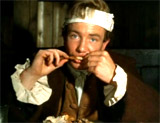 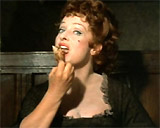
|
|||||||||
|
# 78. The Sound of Music (1965) Could there ever be a better opening for the film version of a stage musical than this? With a sweeping aerial view, the film opens with a left-to-right camera pan through the clouds and across rocky, snow-covered mountains. The camera dips into a green, wooded valley with steep cliffs that descend into a snow-fed lake. Reflections of the hills are viewed in the mirror-like images on the water's surface. As the camera moves over the European landscape and village, it discovers an open, green area nestled between the peaks. It moves closer and zooms into the green field, where it finds a happy and joyous Maria (Julie Andrews), a novice Salzburg Austrian nun, walking across the wide expanse of land. With open-armed appreciation of the beauty of the surrounding majestic peaks and vistas of the Austrian Alps, she twirls and sings the title song. For her: "The Hills Are Alive With the Sound of Music." Because she spends so much time singing and dancing on the mountainside, she has neglected most of her postulant duties and is asked to leave the nunnery. She takes a job as governess for the family of the widowed Captain von Trapp (Christopher Plummer), and wins over the seven singing children - the Trapp Family Singers, with her warm-heartedness and sense of humor. |
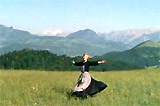  
|
|||||||||
|
# 79. Bonnie and Clyde (1967) This film is one of the sixties' most talked-about, controversial crime/gangster films - its graphically, lyrically violent finale permanently changed the form and substance of popular films forever. Drifter Clyde Barrow (Warren Beatty) and his bored, beautiful, and sexually-frustrated, Depression-era partner Bonnie Parker (Faye Dunaway) go on a cross-country, bank-robbing rampage, and are eventually betrayed. The most classic of all scenes is the shocking and tense "ballet of blood" finale, an ultra-violent, country backroads ambush set for Bonnie and Clyde, the doomed lovers. Sidekick C. W.'s Moss's (Michael J. Pollard) father Ivan (Dub Taylor) fakes a flat tire on his truck, knowing that the couple will be driving by. The ambush scene is marvelously choreographed and edited as it carefully builds to the climax. Quick shots jump through each moment and capture the faces of the characters. Moss notices their car coming down the road and flags it down for help. Another unexpected car appears, a flock of birds flies upward, thick shrubs rustle across the road, and Moss dives beneath his truck for safety. In the shooting and editing of the massacre, slow motion scenes are intercut with sped-up motion - creating a nervous montage of images. In their final freeze-frame of life, with a silent glance at each other, Bonnie and Clyde reveal both panic and love. Then, from the point of view of the deputies, their frenzied corpses agonizingly writhe in slow-motion as they vainly grasp for each other. Gunned down, 'shot,' and riddled with bullets, they die prolonged, cinematically-beautiful deaths to accentuate the romance of the myths and the larger-than-life legends that surrounded them. Their corpses are re-animated with slow, jerking spasms by gunfire that shreds them and the shrubbery. Clyde's body hits the brown dirt, and Bonnie's is hit over and over again in the front seat of the bullet-marked car. Her golden hair hangs down in the sunlight. Texas Ranger (Denver Pyle) walks up with the other officers, lowers his carbine, and stares at the scene of carnage. |
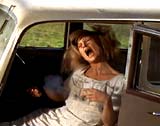 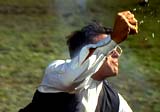  
|
|||||||||
|
# 80. The Graduate (1967) This biting satire/comedy perfectly captures the theme of an innocent youth, exploited and betrayed by a corrupt, decadent, and discredited older generation - the coming of age film beautifully epitomized the spirit of its times. In the memorable, climactic rescue scene at the film's conclusion, recent college graduate Benjamin Braddock (Dustin Hoffman) makes a mad rush to stop the wedding of Elaine (Katharine Ross), the girl he loves - and the daughter of her seductive mother Mrs. Robinson (Anne Bancroft). He runs toward the West Coast church, filmed with an extreme depth of focus camera that makes him appear to be running in place and not getting anywhere. He halts the marriage from the church balcony, looking down through a pane of glass (in a crucifixion image) as the ceremony concludes. He pounds on the glass, calling out "Elaine! Elaine! Elaine! Elaine!" The bride looks up - startled. Elaine is torn between Benjamin and her parents and new husband. Mr. Robinson reacts to his appearance with anger: "Who's that guy? What's he doing? I'll take care of him." Mrs. Robinson clucks: "He's too late." Elaine walks slowly to the back of the church, her eyes transfixed on Benjamin. She chooses him over her bridegroom, screaming out: "Ben!" Benjamin knocks Mr. Robinson to the floor, pushes the bridegroom back, and grabs Elaine, as Mrs. Robinson confronts her daughter, again exclaiming: "It's too late." Elaine rebelliously disagrees: "Not for me." Mrs. Robinson slaps Elaine twice across the face to bring her back to reality, but the blows have no effect. Elaine and Benjamin run out of the church together, using a large church cross he has pulled down from the wall - first as a weapon to clear a path and then as a barrier for the large glass doors to prevent everyone from following. With the glass door securely locked, they symbolically and literally hold back the forces of resistance. Elaine, still in her bridal gown, and Benjamin, grubby and unshaven, run to flag down and board a passing yellow municipal bus while giggling and laughing at their triumphant victory. They rush to the rear seat of the bus and look out the rear glass window, amidst puzzling, stern and cold looks from the other elderly passengers. Oblivious to the other gawking passengers in front of them, the two of them face each other and grin, but their self-satisfied moods begin to fade and disappear. Appropriately, Simon and Garfunkel's "The Sounds of Silence" is reprised on the soundtrack. Emotionally exhausted and confused in the final image, they ride staring silently ahead, uncharacteristically silent and not looking at each other. [Their relationship is maybe not much different from the one Benjamin experienced with Elaine's mother.] They are traveling toward an undefined, uncertain future - stunned and out of breath - well aware that their futures are wide-open and very ambiguous. Ben has won the object of his Holy Grail quest, but nothing is certain for him. The final image views the couple through the rear glass windows of the bus as it pulls away - they are separated from their families and each other.
|
 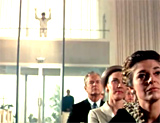     
|
|||||||||
|
# 81. 2001: A Space Odyssey (1968) Stanley Kubrick's towering sci-fi epic was a film in three parts. It opens with The Dawn of Man in the prehistoric past four million years ago, the location where the human race itself began. As the sun rises on the dawn of civilization in a landscape of desert on the African savannah, a peaceful band or tribe of prehistoric ape-men (Australopithecines) appear, squat and hairy, eating grass, scratching and chattering in groups around a slowly diminishing watering hole. They scrape together a meager life, unable to fully protect themselves from the elements or from other competitors, predators and carnivores. There are endless eons of time that pass during which the apes live in eternal boredom - and cope with the struggle for survival. The band of vegetarian man-apes huddle in fear. After the appearance - in the first light of dawn - of a tall, black, rectangular monolithic slab, with an eerie humming sound, they react nervously but soon approach it cautiously, drawn to its color, form, and smoothness - and then they touch it. The leader man-ape plays with one of the ravaged bones from an antelope skeleton. In a slow-motion sequence, he uses the bone to smash at and shatter the skeleton. The ape learns to grasp and use skeleton bones as tools, extending his reach and strike power. Somehow, the monolith has been presented as a gift to mysteriously assist the man-ape in his transition to a higher order with an ability to reason and the power to use tools (such as bones). The creature is able to kill a water buffalo with his new tool, in a brilliant intercut image. The man-ape is on the verge of intelligence - the beginning of steps toward humanity. No longer vegetarian, the group of man-apes that have experienced the breakthrough eat the raw meat from their fresh kill. When other man-apes come over to the water hole, the intelligent man-apes drive them away by attacking and swinging with their bone-tools, now using them as weapons to kill or threaten other man-apes. They gain domination in the animal world, establish their territorial domain, and take an evolutionary step or leap toward (or away from) humanity. The leader man-ape uses the bone to crush an opponent's skull from the nearest other tribe of proto-humans. While continuing to demolish the skeleton with the bone, in slow-motion, he throws his weapon, a piece of the bone, exultantly into the air. It flies and spins upwards, twisting and turning. In a great transitionary image to the next segment, the tossed tool/weapon instantly rotates and dissolves into an Earth-orbiting satellite - a technological instrument, tool, or machine from another era that was ultimately derived from the first tool-weapon. [Another superb sequence: as the two astronauts speak to each other in a sound-proof chamber so that the spaceship's malevolent computer HAL cannot hear them, the computer's electronic red 'eye' reads their lips through the window of the compartment.] |
    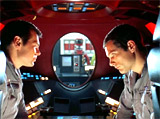 
|
|||||||||
|
# 82. Butch Cassidy and the Sundance Kid (1969) George Roy Hill's entertaining, whimsical, hit production of the comedy/drama western was about two legendary, turn-of-the-century Western outlaws faced with inevitable changes in the twentieth century. Train-robbing Butch Cassidy (Paul Newman) and Sundance (Robert Redford) are endlessly pursued by a relentless, superhuman posse (often filmed with a long focal-length lens) led by a feared lawmen in the West - a sheriff in a white hat named Joe Lefors, and an expert Indian tracker named Lord Baltimore. They repeatedly ask each other the bewildering question - as they look over their shoulders and try to evade the Pinkerton posse: "Who are those guys?" The outlaws are chased over rocks and creeks, and eventually trapped on a ledge at the edge of a steep canyon with nowhere to go. Their frequent comic bantering is a highlight of the film, especially illustrated when they overlook raging rapids far below and are faced with a choice between a hopeless shoot-out and a near-suicidal leap. At the last moment, Sundance confesses: "I can't swim!" His partner Butch guffaws: "Why, you crazy - the fall'll probably kill ya!" Sundance shakes his head as he ponders the insanity of actually jumping to escape their pursuers. He grabs a gun belt held out by Butch, jumps with him in tandem, and wails: "Ohhh . . . s - h - i - i - i - i - i - t !" [In the film's final sequence, the two are cornered and wounded by Bolivian troops in an empty stucco building - they still bicker with each other, giving a mocking, ironic edge to their words. While bleeding badly, they are quickly surrounded by an entire regiment, but they daydream and optimistically talk of new places to go, even debating wistfully about the possibility of emigrating to Australia and starting a new life there. The two are unable to comprehend the reality of their doomed situation that awaits them outside. Escape is impossible. After they have loaded their guns and positioned guns in their hands, they ready themselves for a daylight dash toward their horses. They emerge with guns blazing from their hiding place for their last shootout against impossible odds in the small-town courtyard. Rather than ending the film in bullet-ridden deaths, the picture ends with a freeze-frame of their final glorious charge, drowned out by the echoing sounds of thousands of guns firing on them from all angles. The image freezes, blurs, and then keeps a sepia-toned focus on the legendary, eternal bravura image of the two compadres in their final gallant moments as they meet their fate together.] |
  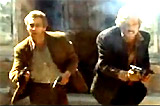 
|
|||||||||
|
# 83. Easy Rider (1969) This is the late 1960s "road film" tale of a search for freedom (or the illusion of freedom) in a conformist America, in the midst of paranoia, bigotry and violence. The iconographic "buddy" film is both memorialized as an image of the popular and historical culture of the time and a story of a contemporary journey eastward through the American Southwest by two self-righteous, anti-hero, free-wheeling, long-haired, social misfits / dropouts / hippies. The bikers are the cool and introspective "Captain America" Wyatt (Peter Fonda) with an American flag on the back of his black leather jacket and a stars-and-stripes helmet, and mustached Billy (Dennis Hopper) with a tan-colored bush hat and fringed jacket on his gleaming, silver-chromed, low-riding motorcycle. When they are both thrown in jail in a small town in New Mexico for crashing a parade and "paradin' without a permit," they meet a genial, drunken ACLU Southern lawyer, George Hanson (Jack Nicholson). George presents the most unforgettable image of the film after he tells them he has "a helmet." He is grinning from ear to ear, wearing a gold football helmet, and riding on the back of Wyatt's motorcycle, as "If You Want to Be A Bird" (by The Holy Modal Rounders) plays on the soundtrack. George sits up and flaps his arms. |
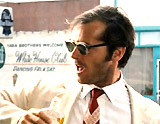 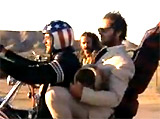 
|
|||||||||
|
# 84. The Wild Bunch (1969) The best of Sam Peckinpah's westerns - the harsh, extremely violent cinematically visualizes at both its beginning and end (with rapid-fire and slow-motion segments) the horrific, savage, yet glorified spectacle of death for a romantic band of men whose time had come. The film's opening with freeze-frame credits is brilliantly presented. To the sound of snare drums and cymbals, the over-the-hill Wild Bunch outlaws (including William Holden, Ernest Borgnine, Warren Oates, and Ben Johnson) masquerade in the disguise of tan-colored, khaki outfits as U.S. Cavalry soldiers. They appear heroically-positioned, riding stiffly and formally into a dusty town of San Rafael along railroad tracks. The frame freezes into a static, black and white chiaroscuro image when each of the credits appear, unfreezing to continue with the colorful action. On the outskirts of the southwestern Texas town, they ride by a large gathering of Mexican children who are being entertained by toying with scorpions (a symbol or parable of the Wild Bunch itself) placed in the middle of a caged colony of red fighter ants - in reaction shots, the children watch and giggle as the struggling scorpions are surrounded, tortured and consumed by the swarming ants. In the opening street scene outside railroad offices that they rob, they are unaware that they are hugely outnumbered - there is an ambush prepared by the railroad bosses who have placed bands of bounty-hunting riflemen on a rooftop. To increase the tension of the scene, the film is sharply edited, inter-cutting rapidly from the Bunch in the bank, to the bounty hunters, to the temperance marchers. The oncoming temperance union marchers on parade through the street are used to the Wild Bunch's advantage as shields and cover. In the blood ballet (partially filmed in poetic slow motion), many of the bullets strike innocent bystanders in the crowd - men, women, and children in the parade are caught in the crossfire. Bullet wounds spray gushing blood and chunks of flesh, and bodies writhe in agony and pain. One of the memorable images is the sight of one of the escaping, yellow-raincoated riders being shot from his horse and cascading-smashing through a store-front glass window of a dress shop and rolling into three dress mannequins. On the outskirts of town, the decimated gang pauses by the children who are still playing with their captured and devoured scorpions. The youngsters toss dry straw on the caged scorpions and ants, setting the whole pile afire. [The closing scene of the ultimate showdown with the Mexican soldiers - a bloody orgy of carnage and slaughter, is equally lyrical and repellent.] |
      
|
|||||||||
1950s (1) | 1950s (2) | 1960s | 1970-90s |
|